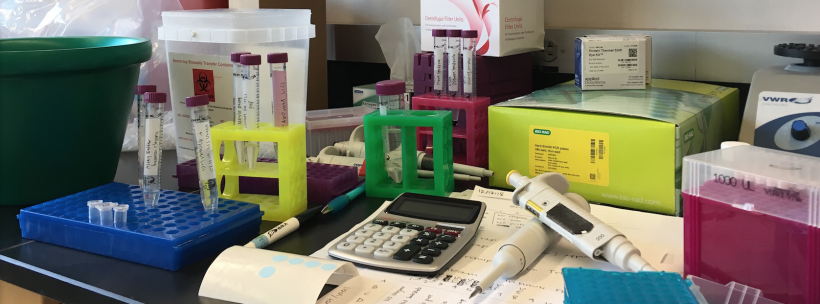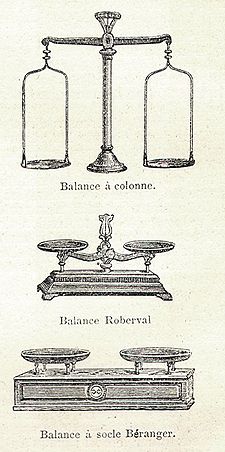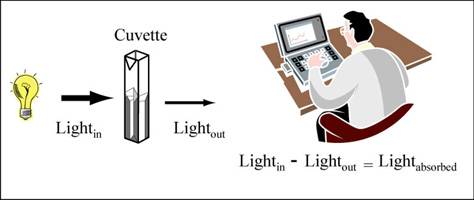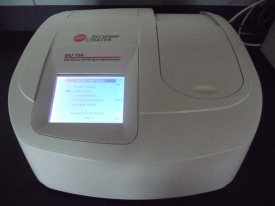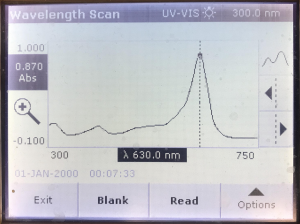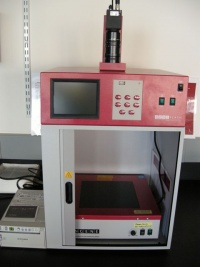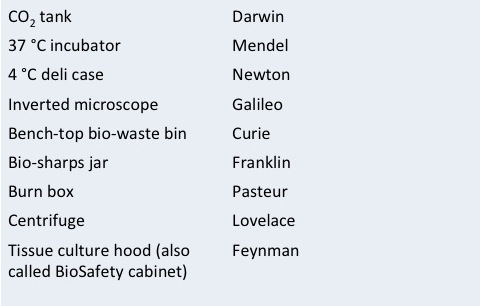20.109(S19):Laboratory tour
Contents
- 1 Introduction
- 2 Student registration and questionnaire
- 3 Interactive and equipment stations
- 4 Benchwork and scavenger stations
- 5 Tissue culture station
- 6 Prep notes
Introduction
We'll start the day at 1:05 pm with General BioSafety training from the Environment, Health and Safety Office. Afterwards, you'll pick your lab partner, bench, and then get to know everyone in the class. We'll do a pretty extensive introduction to our class wiki and then there are eight stations for you and your lab partner to visit on your lab tour today. Some will be guided tours with a TA or faculty there to help you and others are self-guided, leaving you and your partner to try things on your own. Your visit to each station should last ~10-15 minutes. It doesn’t matter which station you visit first but you must visit them all before you leave today. Afterward, you should have some time remaining to begin the Homework assignment, and are strongly encouraged to do so. Your lab practical quiz next time will assess your mastery of a selection of these stations - all are fair game, as is the lab safety material covered in today's pre-lab lecture.
Student registration and questionnaire
Let's get to know each other...
Please paste this section into a word editor, fill in the answers, and upload your document to Stellar.
- Last name:
- First name:
- Preferred name / nickname (if not first):
- Course / minor:
- Year of graduation:
- Telephone number (in case we can't find you!):
- Email address:
- Have you taken / are you taking (yes/no + when)?
- 7.05/5.07 (biochemistry)
- 7.06 (cell biology)
- 7.03 (genetics)
- 5.310 (general chemistry lab)
- BioSafety training by MIT EHS
- Do you have experience with... (yes/no + type)?
- Cell culture (microbial/mammalian/yeast?)
- Molecular biology (electrophoresis, PCR, etc)
- Please briefly describe any previous laboratory experience:
- Are you planning on UROP'ing this semester? in which lab?
- Which student organizations / varsity teams are you part of?
- What is your favorite hobby these days?
- Anything else you'd like us to know about you?
Please sign your name (with signature image or electronically) under the following statement to indicate your agreement: I have read and understood the 20.109 statement on collaboration and integrity.
You can also print this section, sign it and hand it to the instructor.
Statement on collaboration and integrity
Part of becoming a scientist/engineer is learning the ethical conventions of one's discipline. We ask you to rigorously present your results and to cite others' work appropriately not as arbitrary hoops to jump through but as part of your professional training. Integrity in depicting results improves reproducibility and reduces unnecessary frustration in the community who tries to build upon those results. Integrity in citing sources not only gives credit to those who have earned it, but also lets others independently assess the merits of both the original work and the conclusions you have drawn from it.
In 20.109, documentation of your experiments must be completed entirely by you unless otherwise stated. Thus, while we encourage you to discuss your results with your lab partner and other classmates, you may not share text or figures when completing homework assignments, the Module 1 mini-presentation, or the Module 2 report. (The Module 1 and Module 3 data summaries will be completed in pairs or larger groups.) Please do not plagiarize -- accidentally or otherwise -- the class wiki or any other writing/images available online or elsewhere. Note that plagiarism is often unintentional, so take the responsibility now to learn the difference between appropriate paraphrasing and academic dishonesty. The following links may help you in this endeavor:
- MIT Libraries overview on citation, especially
- Consequences of academic dishonesty, from MIT Academic Integrity Handbook
Finally, in order for you to have the most meaningful learning experience possible, and to maintain a fair playing field for all students in the class, we ask that you do not look at completed assignments for similar modules run in previous years.
Interactive and equipment stations
Station 1: Introduction to pipetting (guided)
Someone will show you how to use your pipetmen, and then you will use them to dilute a blue dye (0.1% food coloring). Bring your pipetmen, tips, and cuvette rack with you.
- If you have never used pipet men, then you should practice by pipeting 800, 80 and 8 μL of the 0.1% food coloring stock into eppendorf tubes. Pipet each volume three times and visually inspect how well the volumes match.
- Below, be sure to use the pipet specified in each step in order to test the calibration of all three.
- Using your P20, measure 10, 15 and 20 μL of the 0.1% food coloring stock solution into the bottom of three cuvettes. Using your P1000, add water to bring the final volume to 1 mL (=1000 μL) and pipet up and down to mix.
- Alternatively, add the small volume to the larger one while immersing your food coloring-filled pipet tip in the water. When you are all done, cover the cuvette with a gloved finger and invert several times to thoroughly mix the contents.
- Using your P200, measure 20, 50 and 100 μL of the 0.1% food coloring stock solution into the bottom of three more cuvettes. Using your P1000, add water to bring the final volume to 1 mL.
- Using your P1000, measure 100, 200, and 400 μL of 0.1% food coloring solution into the bottom of three more cuvettes. Add water to bring the final volume to 1 mL.
- Visually compare your dilutions to the reference ones. Do not throw them away: if time permits, you will read the absorbance of your dilutions in the spectrophotometer. Measure 1 mL of plain water now to serve as your blank at the spec.
Station 2: Introduction to making solutions (self-guided)
Making solutions is a fundamental part of being in lab, and the success of your experiments is absolutely dependent on doing it correctly and consistently. Here you will make 40 mL of a 2% (w/v) dextrose solution. If you are unclear about any of the following instructions, be sure to ask for help.
Part 1: At the balance
- Put on gloves and eye protection to weigh out solids. This protects you from the chemicals and protects the chemicals from getting contaminated with anything foreign on your hands. Dextrose is a sugar; it is not a dangerous chemical.
- Zero the balance with a weigh boat on it. Weigh boats are kept in the drawer under the balance. The button marked -> O/T <- will zero (“tare”) the balance and the display should read 0.0000 after taring. Be sure to close the balance doors when taring the balance.
- Use a spatula to measure 0.80 grams of dextrose. Open the balance doors and hold the spatula and chemical over the weigh boat. Begin by adding only a small amount of the powder to the weigh boat. Once you determine how much that weighs, you can add correspondingly more. If you have weighed out too much, you can put some back as long as you have used a clean spatula and a clean weigh boat.
- Remove the weigh boat with your dextrose from the balance, gently bend the corners together and pour the contents into a 50 mL conical tube. Tap the back of the weigh boat to loosen any powder that is stuck. The weigh boat can be discarded in the trash since dextrose is not dangerous.
- Clean the balance with a brush. Clean the area around the balance with a damp paper towel.
Part 2: Measuring liquids and mixing
You want the solution to have a final volume of 40 mL. Since the dextrose will take up some volume, start with 30 mL of water, add the dextrose, and then adjust the final volume of the solution to 40 mL.
- Measure approximately 30 mL of distilled water - using the far left-hand faucet at any lab sink - into a 100 mL graduated cylinder. Read the volume in the cylinder by bringing it to eye level to see where the meniscus reaches. Add the water to the 50 mL conical tube containing your dextrose.
- Vortex until all the powder is dissolved.
- Pour the solution back into your graduated cylinder.
- Add distilled water up to 40 mL using a plastic disposable pipet and electronic pipette.
- To open the pipet, hold it in one hand; with your other hand, puncture the wrapper by pulling it against the top of the pipet (not the end with the tip!). Put the exposed end of the pipet into an electronic pipette, then withdraw the pipet from the rest of the wrapper.
- Place the tip of the pipet into the distilled water and withdraw enough liquid to “top off” your solution. Dispense the water into your dextrose while submerging the pipet tip in the solution. Stop when the graduated cylinder reads 40 mL. Extra water can be discarded into the sink and the used pipet can be discarded in the "burn box" near the teaching bench.
- Rinse the graduated cylinder with distilled water.
Station 3: Introduction to our spectrophotometer (self-guided)
Color is created when white light strikes a molecule that then reflects light of a certain wavelength and absorbs all the others. A spectrophotometer is an instrument that measures the amount of light absorbed by a sample. It does this by shining light of a particular wavelength into a sample and measuring how much light comes all the way through. Samples are held in cuvettes between the light source and the detector.
Here are two important things to remember about spectrophotometers. First, different compounds absorb different wavelengths of light. The color you see is from wavelengths that are reflected by the compound, while the other wavelengths you don't see are absorbed by the compound. For example, red pigments absorb greenish blueish light (light of ~400 nm wavelengths) and blue pigments absorb orangish reddish light (light of ~600 nm wavelengths). Therefore all spectrophotometers have ways of adjusting the wavelength of light shining into the sample. The second important point is that the amount of light absorbed by a sample is directly proportional to the concentration of that sample. This is a very useful relationship, making the spectrophotometer a valuable research tool.
In this assay you will investigate the calibration of your pipets by measuring the absorbance of the food coloring dilutions you made (or the sample solutions). According to Beer’s Law, absorbance is linearly related to concentration by a wavelength- and substance-specific factor called the molar absorptivity (ε). Thus, you’ll see that the graph of absorbance versus volume of 0.1% food coloring is a straight line….or at least it should be!
Using the DU 730 spectrophotometer
- Using your P1000, measure 1 mL of water into a plastic cuvette. This cuvette will serve as your blank for the spectrophotometer.
- Follow the touch screen to select "Fixed Wavelength" of 630 nm.
- Insert your water blank into the cuvette holder. Be sure the flat window of the cuvette (and not the indented sides) are in the light beam that travels from front to back (this is different from the beam's direction in the other machines you may have used). Close the door, then touch "Blank" to blank the machine.
- Replace the blank with your first sample, close the door to the spectrophotometer, then touch "Read." Record this value.
- Measure all 9 samples. Remember to remove the final cuvette, then close the door. Note: these values will be used to complete Station 8.
- Next, follow the touch screen back to the main menu and select "Wavelength Scan".
- Again, blank the machine with your water cuvette.
- Scan one of your food coloring samples. Does the output resemble the sample shown here? How does it differ (if at all)? Do you know why? Do you know why there is a peak at ~630 nm?
- Dispose of your food coloring dilutions down the drain and dispose of the cuvettes in the biowaste bin.
Station 4: Gel documentation station
This term we will use a gel documentation station to photograph agarose gels illuminated with UV light. Today you will practice focusing on an object and then capturing and printing the image. You must wear gloves when you touch any part of this equipment since a carcinogenic chemical (ethidium bromide) has been used here to visualize nucleic acids in agarose gels.
After you have put on gloves, try the following:
- Insert your team flash drive into the USB port before turning on the gel box.
- Open the gel documentation cabinet by sliding the door to the left.
- Put the test slide on the dark section of the UV transilluminator box that's on the bottom of the cabinet.
- With the cabinet door open, turn the power switch that's on the front of the cabinet to ON. This step may have been done already by another group.
- With the cabinet door open, turn the white light switch that's on the front of the cabinet to ON.
- On the upper control panel, touch the upper left button that reads "LIVE."
- Using the image on the screen as your guide, center the test slide in the field of view.
- Focus and zoom as needed using the middle "zoom" dial on the lens that's at the very top of the cabinet. The label for each dial can be found on the left of the lens.
- When you are happy with the picture on the screen, close the cabinet door and turn the white light switch OFF. Now turn the UV switch that's on the front of the cabinet to ON. The UV light (302 nm) can damage your eyes and burn your skin but the cabinet is fitted with a safety switch so the door must be closed for the light to turn on.
- Consider the image you now see on the screen. If the screen is black, use the upward arrow key on the keypad to increase the light exposure time. On the other hand, if you see red areas on the image this color indicates saturation, and you should use the downward arrow key to decrease the exposure time.
- Once you are happy with the image, press "FREEZE" and then "SAVE" on the front keypad.
- Turn the UV light switch to "OFF," then the Power switch to "OFF." (You can leave the power on if and only if another group is ready and waiting.)
- Note: when you are examining DNA gels using the gel box in the future, you'll want to minimize the amount of time the gel is under the UV light. Therefore, you can turn the UV light off once you press FREEZE and before you SAVE your image!
- Remove the test slide from the UV transilluminator and then close the cabinet door to leave the machine as you found it.
Benchwork and scavenger stations
Station 5: Introduction to lab safety equipment (self-guided)
Locate the following essential safety items in or near the lab. Write down where they are and an instance of when you'd use them. Feel free to ask for hints as needed.
- Safety shower
- Spill kits
- Eyewash stations
- Biohazard bench-top buckets
- Biohazard sharps jars
- Biohazard burn boxes
- Liquid vacuum flask disposal
- Chemical fume hood
Station 6: Graphing your data (self-guided)
- Use Excel to prepare a graph of absorbance versus volume of 0.1% food coloring. If you haven't yet visited station 3 you can use the sample data that's linked here. Some sample graphs are reproduced below and you should generate similar ones with your data. Be sure to include a trendline, displaying its equation as well as the r-squared value on the graph. The r-squared value reflects how well the data points fit the equation. A perfect fit will give an r-squared value of 1. If you are uncertain how to make such a graph using Excel, be sure to ask for help. We will use Excel a lot this semester.
- Axis labels can be made by going to View → Formatting Palette → Chart Options.
- If the pipets were well calibrated and the measurements were done carefully, then the points should fall close to a straight line, and the r-squared will be close to 1. If one point seems way off, you can re-test that pipetman. If the repeat data still does not look linear, we can clean the inner workings of your pipetman. Note that the highest food coloring concentration may not fall in the linear range of the experiment.
- There should also be good agreement between the 20 μL measurements made with the P20 and the P200 as well as the 100 μL measurements made with the P200 and P1000. Is there?
- Confirm that your data can print from your laptops to the sleaterkinney.mit.edu printer located under the front of the teaching bench. (Note that it can do duplex printing!) You do not need to turn in your printed graphs.
Station 7: Introduction to lab math (self-guided)
The information and exercises provided here are intended to refresh your memory of basic lab math concepts. If they are entirely new to you or if you are struggling with the practice problems, please ask for extra help. It is absolutely essential that you be comfortable with the information presented here.
Part 1: Metric system
This is the numerical language of science. Base units that you will most often use in this class are meters, grams, liters, and moles. These units will be appended with prefixes to modify the unit by a power of ten.
103 = 1000 = 1000/1 = 103/1 kilo (k-) 100 = 1 = 1/1 = 100/1 base unit (-g, -L, -mol…) 10-3 = 0.001 = 1/1000 = 1/103 milli (m-) 10-6 = 0.000001 = 1/1000000 = 1/106 micro (μ-) 10-9 = 0.000000001 = 1/1000000000 = 1/109 nano (n-)
Practice problems:
- The distance between two cells in 800 μm. How many mm is that?
- The amount of dextrose you want to weigh is 1.9 g. How many mg is that?
- The volume you want to measure is 100 mL. How many liters is that?
- Your reaction generates 0.1 μmoles of product. How many nmoles is that?
Scientific notation expresses numbers so there is one digit to the left of the decimal point and that number is multiplied by a power of ten. 2334 becomes 2.334 x 103 and 0.0041 becomes 4.1 x 10-3. Computations are easier with numbers in scientific notation and some numbers are easier to write (602,214,199,000,000,000,000,000 versus 6.02 x 1023).
Practice problems: Convert the following to scientific notation
- 1000
- 2
- 0.0023
- 0.000000467
The metric system and scientific notation go hand in hand, making unit conversions straightforward. For example 100 μL can be converted to mL by writing the starting volume in scientific notation (1.00 x 102 μL) and multiplying by the power of ten that separates the units (1 mL = 1 x 103 μL). Set up every equation so the units will cancel properly when you multiply through.
Practice problems: Be sure you can express your answers in scientific notation.
- How many mL is 100 μL?
- How many mg is 0.023 g?
- How many mmoles is 250 μmoles?
Note: When using scientific notation in the lab, be sure to keep in mind significant digits. Just because a calculator outputs a value to the seventh decimal point, doesn't mean that you actually know that value to such precision! Throughout the semester, please be thoughtful when working with numbers obtained both from direct measurements and from calculations.
Part 2: Concentrations
Molarity (moles/liter) is a common expression of concentration. When making a solution of a particular molarity, you need to know three things: the desired molarity, the desired volume and the formula weight of the compound to be dissolved. The best place to find the formula weight (grams/mole) is on the chemical’s bottle. Calculations are performed by setting up an equation so that the units cancel, leaving grams in the numerator and volume in the denominator.
Another common expression of concentration is percent. Percent solutions are always based on 100 mL. For powdered substances, percent solutions reflect the weight (in grams) in a 100 mL volume (“w/v”). For example, a 10% solution of NaCl is 10 grams in 100 mL of water. In fact a 10% solution of any powdery substance is 10 grams in 100 mL. For liquids, percent solutions reflect the volume in a 100 mL final volume (“v/v”). For example, a 70% ethanol solution is 70 mL of 100% ethanol and 30 mL of water. (Remembering that 1 mL of water weighs 1 gram may help you remember the w/v expression.)
Practice problems:
- You want to make 100 mL of a 0.5 M dextrose solution. The formula weight of the substance you want to dissolve is 180.16 (g/mol). How many grams will you measure?
- You want to make 10 mL of a 0.01% (w/v) solution of a blue dye called Xylene Cyanol. How many grams will you dissolve?
- How would you make 100 mL of a single aqueous solution that is 5% (v/v) acetic acid and 5% methanol?
Part 3: Dilutions
Many solutions are made by diluting concentrated stock solutions. Dilution factors of 1:2, 1:5, 1:10 and 1:100 are common. These dilutions are made by diluting one “part” stock with 1, 4, 9 or 99 “parts” water. For example, you could make 100 mL of a 0.5 M dextrose solution by mixing 10 mL of a 5 M stock solution with 90 mL of water. This is a 1:10 dilution of the stock. The dilution factor can be converted to a fraction to determine the solution’s final concentration (5 M x 1/10 = 0.5 M).
When the dilution factor is less obvious, the formula C1V1 = C2V2 can be used, where C1 is the starting concentration of the stock solution, C2 is the desired concentration, V1 is the volume of stock you’ll need (usually this is your unknown) and V2 is the final volume you want to make. For example, to make 1000 mL of a 0.2 M Tris from a 1.5 M stock you would multiply 1.5 M (V1) = 0.2 M (1000) to find that you will need 133 mL of the stock. To determine how much water to add you would subtract V2 – V1, in this case 1000 mL – 133 mL = 867 mL of water.
When solutions must be diluted several orders of magnitude, then serial dilutions are made. The concentrated stock is progressively diluted, for example using a 1:100 dilution as the new “stock” in another 1:100 dilution. Such a serial dilution produces a solution that is 10,000 times less concentrated than the starting material. One benefit to serial dilutions is that small volumes of each dilution can be made accurately. A drawback is that any pipetting or calculation error is propagated through every dilution.
Practice problems
- How would you make 50 mL of a 1:5 dilution?
- Give the volume of stock and the volume of water necessary to make 50 mL of a 0.25 M solution starting with a 2 M solution.
- A concentrated culture of bacteria has approximately 1 x 108 cells/mL. What is the concentration of bacteria after it has been diluted 1:100? What is the concentration of bacteria if a 1:2 dilution was made of the 1:100?
Station 8: Introduction to course wiki (self-guided)
The great thing about the wiki is that everything is on the wiki, and the bad thing about the wiki is that everything is on the wiki. To help you familiarize yourself with navigating the most important resource in 20.109, answer the following questions as you explore the wiki tabs.
First, the toolbar is located within the header at the top of every page and contains links to the tabs you will use most frequently this semester.- Click the FYI link. This tab contains information on the Teaching Team, including contact information and office hour times. The attendance policy for the course is also included here. What will result if you have an unexcused absence from the laboratory?
- Click the Assignments link. This tab includes information on how your grade will be determined. What is the policy for submitting late work (specifically, how are late assignments graded)?
- Click the Homework link. All of the homework assignments are listed here and organized by the day due. What information is included in the 'Wrapping up...' sub-section?
- Click the Class Data link. Currently there is no information here, but throughout the semester you will post your data to this tab to ensure your class mates have access to it.
- Click the Communication link. The Communication Lab Instructors will provide five workshops this semester to assist you in preparing your major assignments. What will you learn in the first workshop (the link is broken, but you can make an assumption based on the title of the workshop)?
- Click the links associated with each of the modules and briefly review the information on each tab. What type of information is linked to these tabs?
Next, the Schedule tab is the most valuable page and the teaching faculty highly recommend that you bookmark it!
- The lecture slides are posted to the Schedule tab. Where are the Orientation lecture slides posted?
- The prelab slides are also posted to the Schedule tab. Where are the prelab slides for your laboratory section posted?
- What information is linked to the Laboratory Experiments column?
- What information is linked to the Assignments column?
Lastly, you may have noticed that information is linked to several pages (where it is relevant) for ease of navigation.
- List all of the pages you can find that contain a link to the M1 Data summary page. Provide at least three!
Tissue culture station
Review the following resources before you complete the tasks in Sections #8:
Guidelines on using the 20.109 tissue culture facility
Station 9: Introduction to our tissue culture facility
Our lab is very well equipped. The tissue culture facility has six hoods with germicidal lamps, (up to) four incubators for growing mammalian cells, four inverted microscopes, and a tabletop centrifuge. It also has a water bath for warming up solutions and a refrigerator for keeping them cool.
Match the names of the scientists (below) with the equipment the names are taped to. If you have questions, ask one of the teaching faculty.
